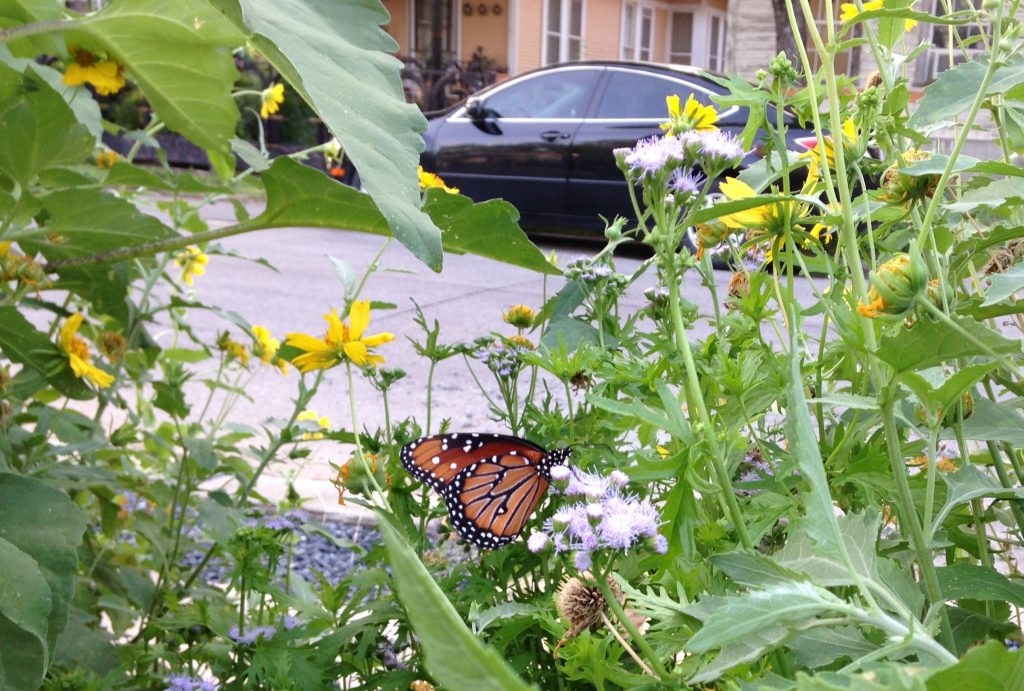In June we posed the question: should we push for 500 pollinator habitats by 2020?
The overwhelming community response: “Let’s do this!”

Pollinator habitats come in all shapes and sizes–in cities, suburbs and everywhere. Queen on Purple Mistflower. Photo by Monika Maeckle
An informal two-question poll of 96 community members conducted on various social media platforms resulted in 93 YES votes and 3 NO votes.
Respondents generally expressed optimism and an upbeat attitude.
“Thanks for promoting pollinator habitat,” said one voter via the comments. “It has changed the way I garden. Our three acres is like living in a wildlife sanctuary. With the native plants, have come birds, bees, butterflies surrounding our home.”
“Recruit cemeteries, golf courses, public parks, military bases, other expanses of landscape with potential for pollinator habitat enhancement!” wrote another community member. “Woo butterflies!” said respondent #67. (The poll allowed for anonymity.)
Other folks chimed in with useful insights.
“We need to have better access to buy milkweed plants to ensure the beautiful monarch migrations,” said one respondent.
Two people left comments that suggest we aspire to greater goals. “Aim high! Try for 1,000 in 2020,” and “Go for 1,000!”
Our 300for300 pollinator habitat initiative was launched in the spring of 2018 as a local initiative, when our hometown of San Antonio was celebrating its Tricentennial Birthday. The idea: create 300 pollinator gardens for San Antonio’s 300th birthday. By December 31, we had exceeded our goal, with 324 habitats pledged. As of this writing, 392 pollinator habitats have been pledged.
The effort resulted from San Antonio’s status as the first Monarch Butterfly Champion City in the country. In December of 2015, San Antonio became the first city in the nation to agree to act on all 24 recommendations made by the National Wildlife Federation to increase urban pollinator habitat as part of the Mayor’s Monarch Pledge. A citywide pollinator gardening initiative was among the action items pledged.
Three hundred habitats in a few months sounded daunting, but when we broke it down into our 10 city council districts–30 per district–it seemed more achievable. And it was.
Since, the 300for300 pollinator habitat initiative has crossed borders beyond the city of San Antonio. We ditched the City Council designation field on our registration page and welcome all comers. Anyone willing to commit to plant a pollinator habitat and who hopes to see it on our map, updated monthly, need only register.
As one voter commented in our poll: “Let’s not be shy about including pollinator gardens outside the vicinity of San Antonio, as we have done in the past. There are many supporters outside the city limits.”
In short, #ButterflieswithoutBorders.
Ready to sign up? Here’s the link.
TOP PHOTO: A sign signaling to the community why your yard may seem messy or “not mowed” helps educate neighbors on the rationale of pollinator habitats. Signs available in our shop.
Related posts:
- 300for300 pollinator initiative: 500 habitats by 2020?
- Popularity of pollinator gardens growing in areas prone to drought
- Planting a butterfly garden? Here’s tips on how to do it
- Mostly native butterfly garden outperforms lawn every time
- A year in the life of an urban butterfly garden
- Downtown River walk plot converts to pollinator garden, creature haven
- Converting your Lawn to a Butterfly Garden
- San Antonio becomes first National Wildlife Federation Monarch Champion city
- Tropical Milkweed: To Plant it or Not is No Simple Question
- How to raise Eastern Swallowtails
- How to raise Monarch butterflies at home
Like what you’re reading? Don’t miss a single post from the Texas Butterfly Ranch. Sign up for email delivery at the very bottom of this page, like us on Facebook, or follow us on Twitter, @monikam.


I live in Coronado, CA and in San Angelo, TX during different times of the year, and have Monarch gardens in both places. Unlike CA where I can pretty much plant whatever I want year around, I deal with deer constantly on the Texas acreage. Currently I have lots of tropical milkweed, have started several others (green, antelope h) that didn’t make it for some reason, one Incarnata that is struggling and and one Tubersosa that is green, but not thriving. This was going to be my “test year” of trying 1 ea of plants to see what thrived and what didn’t. I keep lots of buddleia and salvias around which the deer avoid, but much of what I tried this spring was just eaten right off the top. I have some tall zinnias (seed from my CA garden) which have survived, and some eaten right to the dirt. I plan to plant and scatter more seeds of various kinds this fall for next spring. Water is not a problem as we have an irrigation system which can be controlled. Any suggestions on planting? My Cowpens Daisies didn’t last either. We did have a lot of wild Prairie Verbena bloom in the local area due to the rain, but I never saw any butterflies except the locals which are small. I had one tiger swallowtail (or lookalike) pass through last week.
Last fall I had quite a few Monarchs pass through the yard in Oct-Nov, stopping by 4 Chaste Trees (Vitex) which had leftover and waning flowers on them. I always seem to have lots of queens hanging around at this time also. I need some good nectar plants which can stand the heat, return if there’s a frost (not much of that this year) that the butterflies love and the deer don’t! I built large, raised gardens with good soil and drainage. Short of building a 10′ fence around the garden (we have regular cast-iron horse fencing on the property) what would work? Thanks for your help.
I know guys from Houston who can help you